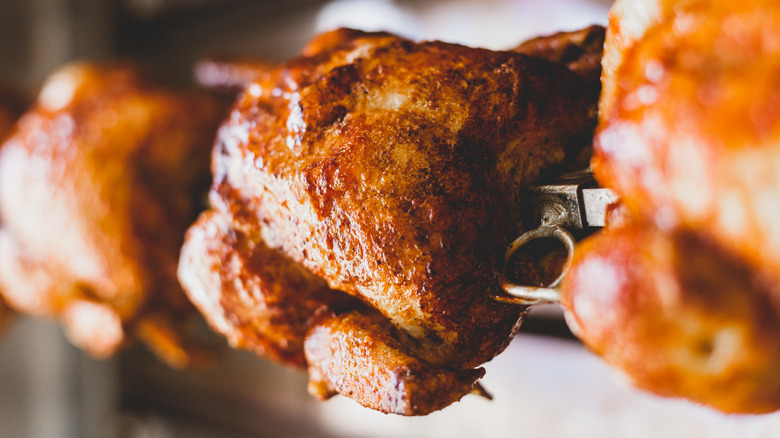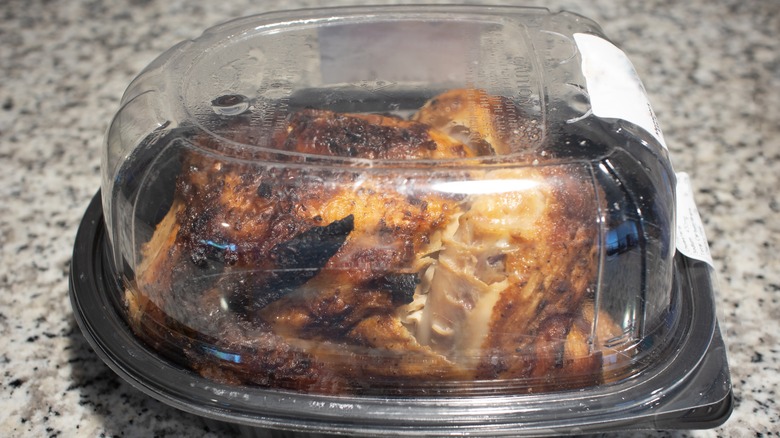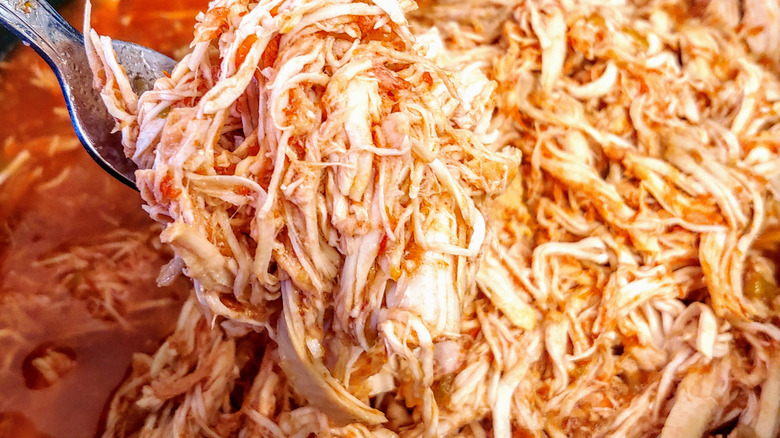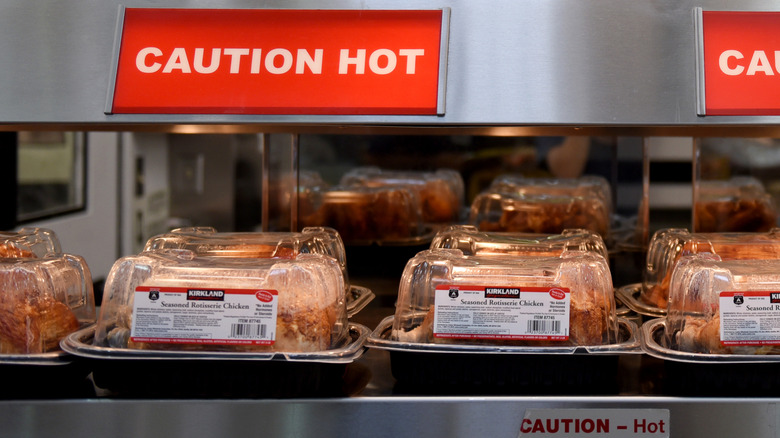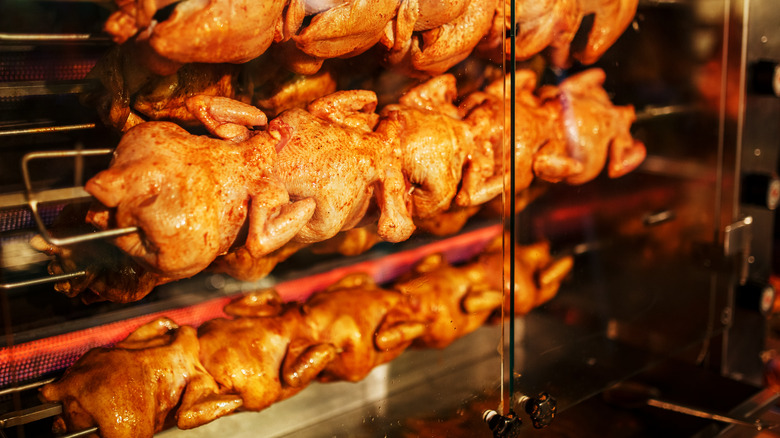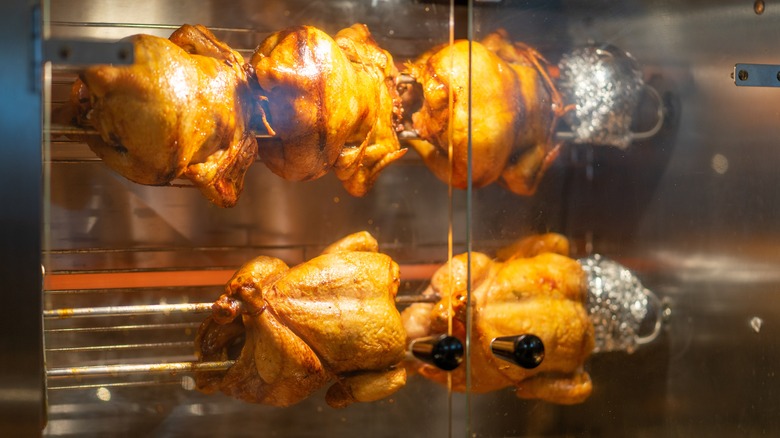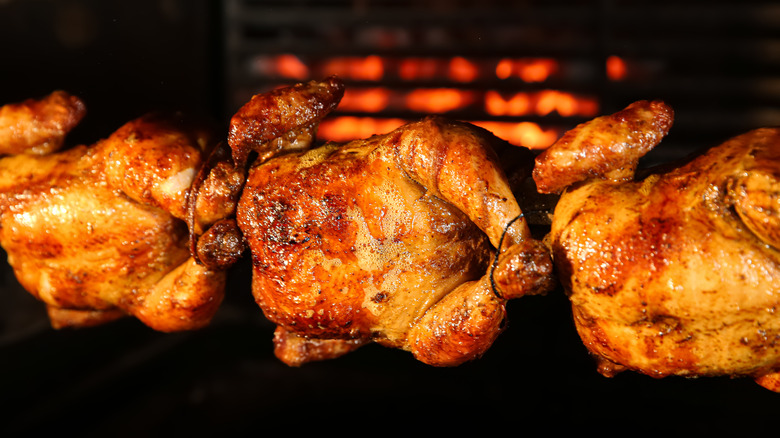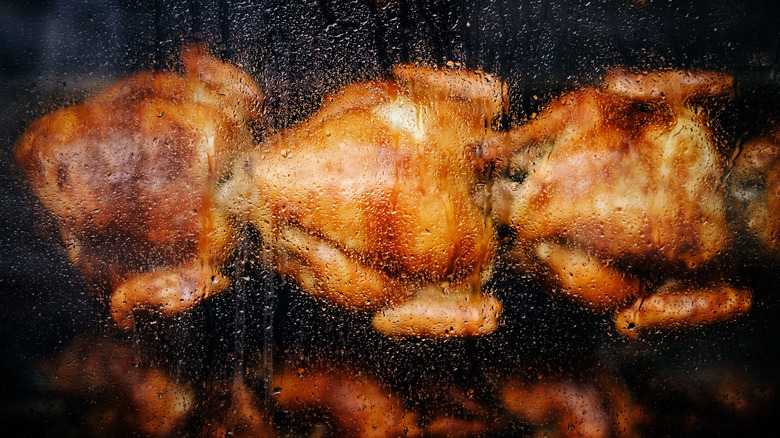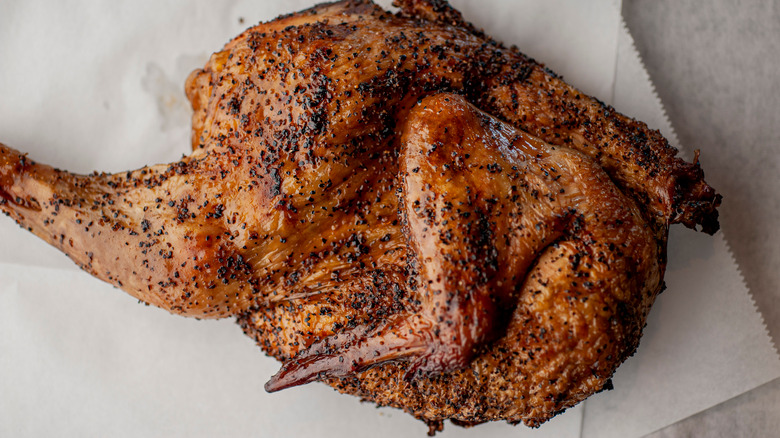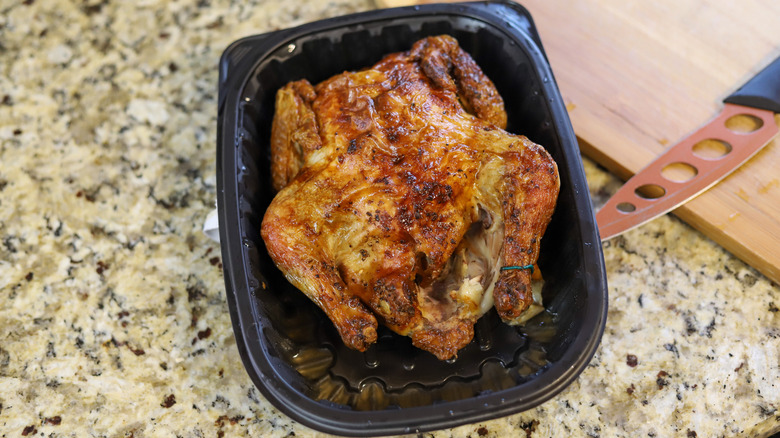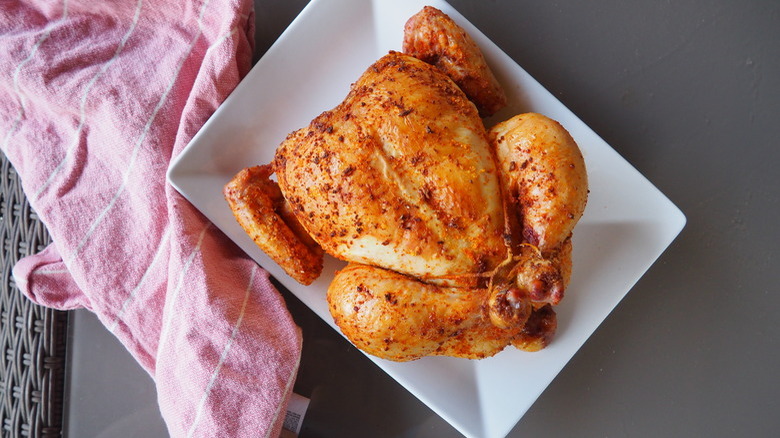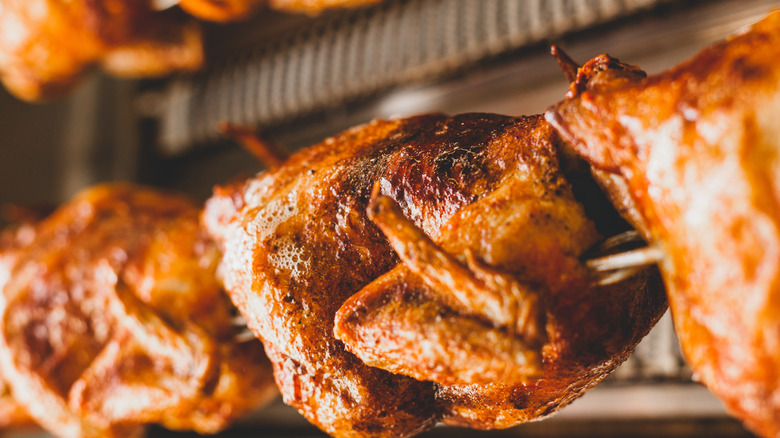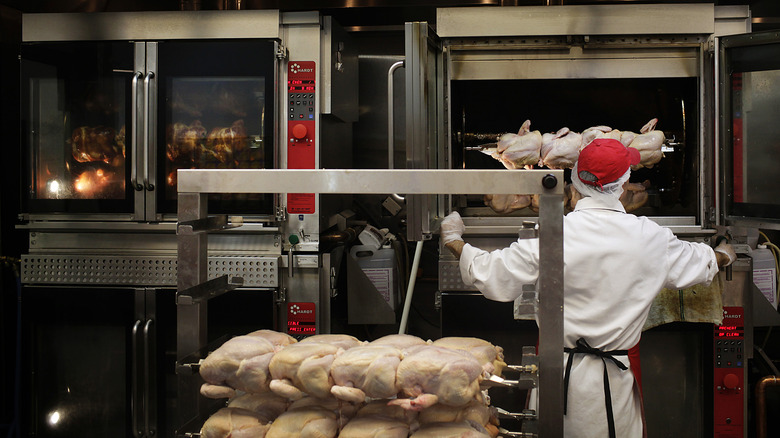Why Store-Bought Rotisserie Chicken Tastes Better Than Homemade
Have you ever found yourself trying to come up with a grocery list just so you can go to the store and buy a rotisserie chicken? Roast chicken is a winning dish that's loved by millions, and that's no exaggeration. It's reported that according to the National Chicken Council, some 950 million rotisserie birds are consumed that are bought from stores each year. You might want to head out for some deals on June 2 as this has been National Rotisserie Chicken Day since 2015.
Whatever the drawbacks of buying a store-bought chicken, and there are quite a few, the reality is that a lot of people love them. They look great, and some varieties taste fantastic too (yes, we're looking at you, Costco rotisserie chicken). And with time being such a huge commodity, who doesn't love the idea of saving some in the kitchen once in a while? And if you love home cooking then once you've enjoyed the crispy skin and tender meat you can make slow-cooker chicken stock if you like.
So why does store-bought rotisserie chicken taste better than homemade — sometimes? Let's find out.
It's hot and ready to eat without any effort
By the time you've cooked an elaborate meal such as a Sunday lunch roast, you can feel anything but hungry. Meanwhile, grabbing takeout from a fast-food joint can leave you feeling over-full and sometimes not satisfied in the right way. When you're looking for a quick, hot, mouthwatering meal that's uber-convenient then grabbing a ready-to-eat, store-bought rotisserie chicken makes perfect sense. Just be sure to put one in your cart once you've finished your grocery shopping, so it stays as hot as possible. Zero effort! All you have to do is wait until you get home, and it's beyond good with a hunk of fresh bread with thick slabs of butter and a ready-made side like coleslaw or even just a slathering of sauce. If you can't wait that long, then nobody's going to judge if you grab a handful — just to taste test it of course — in the car before the ride home.
Just having a whole chicken ready to eat without cooking it makes it taste good, even if you could technically make it better at home. It's an instant family meal, and you can turn it into a simple dish such as a chicken salad if it's cooled down. Chop the chicken after taking it off the bone, and add avocado, red onion, and cilantro. Mix garlic salt and Dijon mustard into mayonnaise and coat the chicken before serving.
It's perfect for shredding for other recipes
There are plenty of recipes that call for shredded chicken. The beauty of rotisserie chicken is that this is just one ingredient used to create many different dishes. It's understandable then that you might not want to spend time and energy roasting a chicken or cooking the meat first before you even start making your final dish. What makes way more sense is using a ready-cooked rotisserie chicken from the store. All you have to do then is chop it up and take the meat off the bones. You can then use two forks to create a shredded texture.
If you're wondering what you can make, then what about some easy chicken tacos? They are ideal when you really don't want to cook much but still want to enjoy a flavorsome meal. To make the filling, fry some onion and bell pepper, before adding the chicken and your own homemade seasoning. Serve the mixture in corn tortillas with whatever tacos toppings you like — such as guac, sour cream, grated cheese, and lettuce. Our chicken enchiladas recipe is the bomb. Add the shredded rotisserie chicken to a tortilla with red sauce, cilantro, and onion, and bake in the oven with sauce and cheese. So good.
The cost is appealing
Convenience often comes at a price. Just think about how much you spend on takeout coffees compared to the price of a cup of joe at home. It's one of the reasons why cooking fresh food is so appealing. Not only do you pay less, but homecooked dishes can be so much better than ready meals and frozen TV dinners. Takeout is often a treat — however, when it comes to store-bought rotisserie chicken, the price is appealing as well as the taste.
Roast chickens in supermarkets are not profit-driven necessarily, meaning the cost is often deliciously low. The price tag can be so tempting that you might end up buying more than one bird. And if you've got any leftovers, then you can use make a rotisserie chicken soup with pasta, fresh thyme, and mirepoix. You even use the bones to thicken the stock, so there really is no waste. If you're wondering why these cooked chickens are so affordable — especially when compared to buying raw chicken to cook at home — then there are a couple of possible reasons. One is that if they weren't turned into rotisserie, the meat would be out of date before it was sold — though this happens pretty infrequently. Interestingly, many stores sell rotisserie chickens at a low price to attract shoppers in the first place, making it a loss leader. Given the ridiculous number of rotisserie chickens that Costco sells, this surely must work.
You can see it cooking before your eyes
Unless you're heading to an eatery where you eat in the dark — and yes, they do exist — you'll probably admit that part of the enjoyment of eating is the anticipation. Before you even take a bite of rotisserie chicken, the aromas entice. And naturally, the look of the birds, as they rotate on the spit, captures your attention, certainly more so than shelves full of dry goods. They almost look like culinary theatre if they are all browning at once. One look at the heat crisping up the skin is enough to pique the appetite — and seeing that happen in real-time is a feast for your eyes.
The fact that you can round the corner of a store where you're already thinking about food and see lots of chickens tantalizingly getting ready to eat is not easy to resist. Grocery shopping can be mighty exhausting and buying a rotisserie chicken to add to a full cart after traipsing up and down aisles can be an uplifting part of the experience. After all, with all those groceries, you're going to be cooking enough fresh meals already, so you deserve a post-shop meal that's already cooked for you.
Multiple chickens are cooked at once in a special oven
The idea of cooking chickens on a rotating spit has been around for a long time. Sometimes, it's just individual spits that rotate while in other set-ups, the spits also move around as they spin too. The purpose of this roasting method is not just to provide a convenient way to cook a lot of chickens at the same time. It does affect the taste and the texture as well. The sheer size and complexity of store rotisseries mean that chickens can be cooked without part of the bird touching the grill or flame. Unless you have an impressive machine at home, it's not so easy to create the same setup.
Lined up in a rotisserie, the juices from the chickens drip down as they cook. This bastes other birds and builds up flavor — as well as keeps the meat nice and succulent and prevents it from drying out. The juices stop the meat from cooking too quickly and also help brown the skin. You can make incredible roast chicken at home whether you baste it or use some other method such as brining. However, unless you've got an industrial-sized oven or your own rotisserie with space for a few chickens, you may not get the same results. The greater the contrast between the crispiness of the skin and the velvety texture of the meat the better.
There are more additives
If you make our twist on Ina Garten's roast chicken, you'll season the bird inside and on the skin — where you rub some mayo too. Inside, you add some orange segments, garlic, and fresh rosemary. A store-bought rotisserie chicken might not taste as good, but if it's tasty, then that's going to be because of the extra ingredients. There might be more of these flavor-enhancing additives or simply greater quantities of them. Taste-aside, consumers should be aware of this, so they can make healthier choices.
You might want to check out if your rotisserie chicken looks better due to caramel coloring. Ingredients such as dextrose and sodium phosphate can also make their way into additive injections, which affect the taste and texture of rotisserie chicken. Sugars are also added to some chickens as well as carrageenan. While this is a natural ingredient that comes from red seaweed, that doesn't mean that it can't have side effects when consumed. It's been linked to food allergies, inflammation, and gluten intolerance, for example. The reality is, that some of the additives in a store-bought rotisserie chicken may enhance the flavor, but you might prefer to know exactly what you're eating.
The skin is often brown and crispy
There are some people — who do actually exist — who take off the skin and only eat the meat of a roast chicken. Often the reason is to reduce the calories and fat intake. But for those who cannot resist it, the browned, crispy skin on a store-bought rotisserie chicken is too flavorful to discard. In fact, some would say it's the best bit. If you're a fan, you'll know just how disappointing it can be when the skin doesn't dry out but somehow stays limp and fatty or thin and papery, making it just slide off the top when you cut into it.
If you can't make it to the store for that pre-roasted chicken, then try our Instant Pot whole-roasted chicken recipe, which browns the skin nicely. However, because the bird cooks in a steamy environment with chicken stock, it's not going to get as crispy as if it's slowly rotating on a spit. Basting chicken, which involves adding juices or fat to meat as it cooks, caramelizes the skin in a more intense way than you can with one chicken in your oven. The browning and crisping occur as a result of what's called the Maillard process. This is when the sugars and amino acids react and brown the skin. More than this, they create a deeper flavor and release mouthwatering aromas. The indirect heat of a rotisserie is perfect for this.
The meat is often juicier
Is there anything worse than dry chicken? Once the moisture has gone from the meat, it can taste tough and stringy — or bland and chewy. A great rotisserie chicken promises melt-in-the-mouth meat. While it won't fall off the bone as it might if it was stewed for a long time on low heat, it should still feel soft. If you're wondering why the chicken you grabbed from the store tastes so much juicier than your own efforts, that could be because the bird has been injected with a salty solution to ensure it doesn't dry out.
Added to this, the whole point of the rotisserie cooking method is that chickens can cook slowly enough to retain moisture, and this happens over a spit. With a few birds in the oven at once, the constant basting from the juices of other chickens ensures that the meat is wonderfully tender. The indirect heat creates a smoky flavor as the skin browns and crisps up. At the same time, the chickens aren't grilled but rather slow-roasted.
If you've got some store-bought chicken leftover, and you're craving another store snack, you could make our copycat Costco chicken bake. Just add chopped-up chicken to rolled-out pizza dough with cheese and cooked bacon bits and make a parcel. Brush with Caesar salad dressing, top with more cheese, and bake in the oven.
There is often more seasoning
You've probably noticed that some stores offer different types of rotisserie chicken such as plain, lemon-herb, or barbecue as standard. If you're making a roast chicken at home, then you can create your own rubs to mimic that delicious store-bought flavor. To make our grilled BBQ half chicken recipe, you massage the skin with a mixture of smoked paprika, onion powder, and garlic powder, as well as black pepper, and salt. Baste with barbecue sauce during cooking. To make chicken flavorful, no matter how you cook it, you need seasoning. However, while these added ingredients may elevate the taste of store-bought rotisserie chickens, it's good to be aware of what these seasonings are.
A major seasoning that's used is salt, and, while at home, you know how much you're adding, do you know how much a store is using for each bird? A Consumer Reports article reveals that Sam's Club membership store rotisserie chickens have around a quarter of the daily recommended amount of sodium per serving. Fortunately, Kroeger and the organic rotisserie chickens from Whole Foods have a lot less salt. While salt, sugars, and spices also boost flavor of the meat, the disadvantage of store-bought varieties is that some are healthier than others. Instead, you could make a dip to add more flavor rather than buy a bird that's over-salted.
In some stores, the quality of the meat is high
When you are shopping for a whole raw chicken, the labeling and price are big indicators of what you're purchasing. You can easily see if a bird is corn-fed or has been raised without antibiotics, and whether it's classified as organic or free-range. With a store-bought rotisserie chicken, there isn't generally the same level of signposting about the standard of meat. When grabbing a rotisserie chicken to make dinner easy, it's just as easy to forget about these kinds of things.
Rotisserie chickens are often bred for a purpose and are often not as large as raw birds in the meat section. As noted above, they are seldom taken from the supermarket shelves because they're about to go out of date. However, some stores make a point of identifying higher-quality meat, and this is reflected in the price. Whole Foods offer an organic rotisserie chicken, for example — and it tastes pretty darn good without fail. The only additives used are salt and organic black pepper, which might account for its good taste. You might find that smaller stores with higher price points buy chickens from more ethical sources and local producers, which can impact flavor.
Not all store-bought rotisserie chicken tastes better
They look great turning on a spit or lined up on a hot counter ready to eat. They often taste moreish because the skin is browned, and the meat is juicy. And rotisserie chickens bought from the store are so convenient that this only increases the allure. Still, some birds definitely taste better than others, and there's a huge difference in terms of additives and how good or potentially unhealthy a roast chicken is for you. However, not all store-bought rotisserie chicken tastes better.
Cooked chickens sold in bags can soon dampen crispy skin making it less appetizing. Birds can be over-seasoned or even not seasoned enough. Meanwhile, if the cooking hasn't been even then this can dry the leaner meat and leave the darker meat tasting chewy. The additives can create a texture that's gummy or tastes separate from the meat. They can make the flavor taste less natural than if you were adding your own herbs and spices at home. Injections to make chickens juicier can also make them taste slimy or watery instead. Find a rotisserie chicken that you love, and it's a game — changer even if you do pay a little more.
You've chosen the right chicken
If you walk past a rotisserie in a grocery store, then you might just see a blur of chickens roasting and many packaged up — ready to pop in your cart. However, while the whole point of grabbing one of these birds is that they promise a quick and easy meal, it's worth spending a few moments to make sure that you've chosen the right chicken. By doing so, your ready-made dinner could taste a lot better, and even rival your own efforts.
If the skin doesn't look brown and crispy, give that bird a miss. However, there's brown — and then there's a deeper shade that may look roasty but not necessarily taste as good. This darker color may suggest that the meat has been roasted for longer. Being in the rotisserie for more time could dry the meat out and make it stringy. If some birds are bigger than others, you might find they are juicier. It's not just the size that impacts how well they cook in a rotisserie, but also the fact that larger chickens may be more mature and tastier. While you can't check out every aspect of a chicken, telltale signs such as blackened parts or skin that looks dried up are less likely to offer the best-tasting meat.
You've bought at the right time
There's often a steady stream of birds cooking on the rotisserie during busy grocery times. That means that the ready-cooked chicken you add to your cart is more likely to be fresh and hasn't been hanging around for too long. Rotisseries are fired up at the start of business hours, and usually close down late afternoon. If you love store-bought chicken off the spit, then you might want to time your grocery shopping to fit with the rotisserie timings. If there's a particular seasoned variety you want, then you might find it's only readily available at certain times of the day.
You probably want chicken that's fresh from a rotisserie that's firing away rather than simply keeping birds warm. And how the end product is packaged may affect how it tastes and whether you feel it's been sitting there too long. If you miss out, then you can always make our copycat Costco rotisserie chicken with just five ingredients. Aside from a whole bird, you need paprika, garlic powder, kosher salt, and ground black pepper. The trick is to dry the skin out first and cook the chicken at a lower temperature for longer than you might with roast chicken. Try it for yourself and check out when it tastes as good as any rotisserie chicken you've added to your grocery shop.
